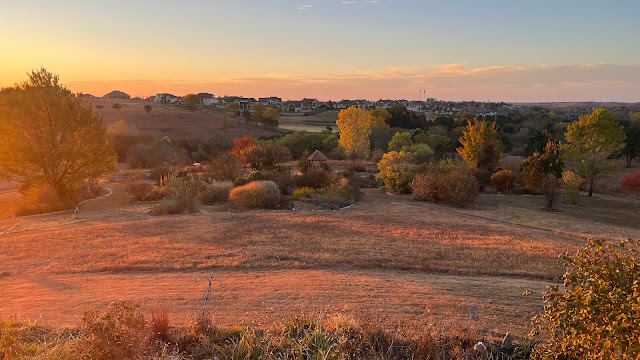Sorry everyone, ProfessorRoush has been absent from the blog a couple of weeks. I was deserted by Mrs. ProfessorRoush for the first week after she made some weak excuse about needing to hold grandchildren and then promptly left Bella and I to fend for ourselves. Last week, missing both her cooking and mere presence, and tired of Bella moping around the house, I tracked Mrs. PR down in the wilds of Alaska, spent a few brief days myself holding the grandchildren while being sick alongside everyone else in the family, and then I dragged her back to Kansas.
.jpg)
No, we didn't get COVID during 19 hours of travel getting there and another 23 hours returning (and yes, all of us tested negative for the virus), but we did catch what seemed to be a plain old common cold from our germ-growing grandchildren, the traditional route to pneumonia and demise for old folks. Such is the cycle of life, but my little microbe-factory descendants didn't count on grandpa having a robust immune system bolstered by plenty of sunlight and clean living and I survived to garden again.
.jpg) |
| 'Scabrosa' |
Unfortunately, we spent most of our time in the Alaskan territory either in airplanes or cuddling indoors, my journeys outside limited to one short hike, during which we came across the showy specimen of
Amanita muscaria pictured at top, delicious in appearance and full of hallucinogens and toxins too numerous to name. Potentially deadly but beautiful, the internet tells me that this species is likely safe to nibble on if I wanted a different type of trip, but I'm not tempted in the slightest. Near the
Amanita, I was able to capture the more typical Alaskan lakeshore scene above, just to prove to naysayers that I was certainly out of Kansas. I was, in fact, hiking in the Kenai National Wildlife Refuge, on a short trail near the visitor's center.
In another brief venture outside the plague house, I was quite happy to find a neglected Rugosa growing by the front steps, pictured above, here, and below, undoubtedly 'Scabrosa' and if it wasn't that variety, it's surely a Rugosa worthy of cultivation. Those deep magenta single blooms are nearly the size of my hand and look at all the healthy deep-green foliage! Here near a coastline, in cool temperatures, nearly daily rain, and partial shade and a USDA 4A climate, this rose is completely defiant to the elements. Hardy is as hardy does, or so an Alaskan Forest Gump might say.
.jpg)
Not even the weird insects crawling all over this bloom seem to disturb it, merely, seemingly, just present to carry pollen from flower to flower. Drawn here, certainly, by the heavy scent of this rugosa or by the enticing color, they are a bit disturbing at first encounter, somewhat revolting to find amid the golden stamens, but they are likely harmless sycophants of the glorious flower. Heck, I don't blame them a bit for I'm a Rugosa syncophant as well and one that could, shrunk down to the right size, easily get lost in the majesty of a cluster of these blooms.
We returned yesterday, my reluctant empty-armed bride and I, transported from the 60's of Alaska to a 101ºF day of early August in Kansas and, arriving home, were immediately greeted by this spectacular clump of
Naked Ladies Surprise Lilies right out front in their full bare-stemmed glory. It was so hot that I was afraid that Mrs. ProfessorRoush might want to join in their carefree display so I ushered her into the house before she created any kind of neighborhood gossip. Anyway, now you know what I've been doing these past two weeks, busy from sunup to sundown, from sneezes and sniffles to nose-wipes to naked ladies. It's been a good two weeks here in my world.




.jpg)
.jpg)
.jpg)
.jpg)
.jpg)
.jpg)
.jpg)
.jpg)
.jpg)
.jpg)
.jpg)



.jpg)
.jpg)
.jpg)
.jpg)
.jpg)
.jpg)

.jpg)







.jpg)
.jpg)
.jpg)
.jpg)
.jpg)
.jpg)
.jpg)
.jpg)
.jpg)

.jpg)

.jpg)
.jpg)
.jpg)
.jpg)
.jpg)
.jpg)
